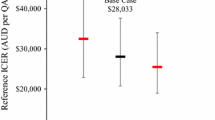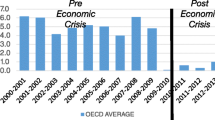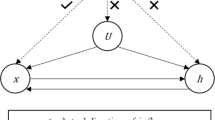Abstract
The fiscal multiplier represents the ratio of the change in national income to an associated increase in government spending. Fiscal multiplier effects are commonly estimated to justify options for government spending. Multiplier effects are not considered in economic evaluations of healthcare, but alternate forms of healthcare spending are expected to have varying multiplier effects. This paper describes the estimation and application of net government spending multiplier effects to two published economic evaluations. Negative net multiplier effects are estimated for an evaluated pharmaceutical for the treatment of stable cardiovascular disease, with a resulting increase in the published incremental cost per quality-adjusted life-year (QALY) gained from AU$31,244 to 47,311. Positive net multiplier effects are estimated for an evaluated healthcare delivery model for frail older people, with a resulting decrease in the published incremental cost per QALY gained from AU$8129 to 7669. The inclusion of net multiplier effects in economic evaluations undertaken from a societal perspective can have important effects on the estimated value of evaluated health technologies and services. The potential for government spending on healthcare to crowd out existing spending is considered low, but further investigation of crowding-out effects is warranted.
Similar content being viewed by others
References
Drost RM, van der Putten IM, Ruwaard D, Evers SM, Paulus AT. Conceptualizations of the societal perspective within economic evaluations: a systematic review. Int J Technol Assess Health Care. 2017;33(2):251–60.
Clarke M GR, Cunningham S. Regional economic multiplier impacts, potential pollinator deficits across crops. Rural Industries Research and Development Corporation; 2017. Contract No.: No 17/001.
Productivity Commission. Disability Care and Support. Canberra; 2011. Contract No.: Report No. 54.
Productivity Commission. Modelling economy-wide effects of future automotive assistance. Productivity Commission, Government of Australia Research Reports; 2008.
Business Council of Australia. Pipeline or pipe dream? Securing Australia’s investment future : overview. Melbourne: Business Council of Australia; 2012.
Charles Sturt University. Growing Our Communities: Charles Sturt University’s Regional Development Report 2010. Charles Sturt University; 2011. Contract No.: JB F1904.
Kookana J, Pham T, Quinn T. Tourism’s contribution to the Australian economy. Canberra: Tourism Research Australia; 2014.
Gretton P. On input-output tables: uses and abuses. Canberra: Productivity Commission; 2013.
Hyvärinen A, Zhang K, Shimizu S, Hoyer PO. Estimation of a structural vector autoregression model using non-gaussianity. J Mach Learn Res. 2010;11(May):1709–31.
Batini N, Eyraud L, Forni L, Weber A. Fiscal multipliers: Size, determinants, and use in macroeconomic projections: International Monetary Fund; 2014.
OECD. Output gap as a percentage of potential GDP: OECD.Stat; 2019. https://stats.oecd.org/index.aspx?queryid=51396.
Australian Institute of Health and Welfare. Health expenditure Australia 2016-17: AIHW; 2018.
Ademi Z, Zomer E, Tonkin A, Liew D. Cost-effectiveness of rivaroxaban and aspirin compared to aspirin alone in patients with stable cardiovascular disease: an Australian perspective. Int J Cardiol. 2018;270:54–9.
Basu P, Joglekar G, Rai S, Suresh P, Vernon J. Analysis of manufacturing costs in pharmaceutical companies. J Pharm Innov. 2008;3(1):30–40.
Lexchin J. Pharmaceutical company spending on research and development and promotion in Canada, 2013-2016: a cohort analysis. J Pharm Policy Pract. 2018;11(1):5.
Australian Bureau of Statistics. Research and experimental development, businesses, Australia 2011–12. Canberra: Australian Bureau of Statistics; 2013.
Department of Health and Ageing. Expenditure and prescriptions twelve months to 30 June 2011. Canberra: Data and Modelling Section, Pharmaceutical Policy and Analysis Branch; 2011.
Australian Tax Office. Corporate tax transparency: report of entity tax information. Australian Tax Office; 2015–2016.
Karnon J, Afzali HHA, Putro GVAA, Thant PW, Dompok A, Cox I, et al. A cost-effectiveness model for frail older persons: development and application to a physiotherapy-based intervention. Appl Health Econ Health Policy. 2017;15(5):635–45.
Aris A, Ansgar L, Panos K. Using health technology assessment to assess the value of new medicines: results of a systematic review and expert consultation across eight European countries. Eur J Health Econ. 2018;19(1):123–52.
Sanders GD, Neumann PJ, Basu A, Brock DW, Feeny D, Krahn M, et al. Recommendations for conduct, methodological practices, and reporting of cost-effectiveness analyses: second panel on cost-effectiveness in health and medicine. JAMA. 2016;316(10):1093–103.
Krol M, Papenburg J, Tan SS, Brouwer W, Hakkaart L. A noticeable difference? Productivity costs related to paid and unpaid work in economic evaluations on expensive drugs. Eur J Health Econ. 2016;17(4):391–402.
Walker S, Griffin S, Asaria M, Tsuchiya A, Sculpher M. Striving for a societal perspective: a framework for economic evaluations when costs and effects fall on multiple sectors and decision makers. Appl Health Econ Health Policy. 2019;17:577–90.
The Treasury. Guide to social cost benefit analysis. New Zealand Government; 2015.
Department of Health. Health Workforce Summaries. National Health Workforce Dataset. https://hwd.health.gov.au/summary.html.
Lomas J, Claxton K, Martin S, Soares M. Resolving the “cost-effective but unaffordable” paradox: estimating the health opportunity costs of nonmarginal budget impacts. Value Health. 2018;21(3):266–75.
Edney LC, Afzali HH, Cheng TC, Karnon J. Estimating the reference incremental cost-effectiveness ratio for the Australian health system. PharmacoEconomics. 2018;36(2):239–52.
Department of Health. Guidelines for preparing submissions to the Pharmaceutical Benefits Advisory Committee (Version 5). Canberra: Australian Government; 2016.
Author information
Authors and Affiliations
Contributions
JK conceptualised and designed the study, undertook the analyses and drafted the manuscript. BP contributed to the design of the study and the drafting of the manuscript.
Corresponding author
Ethics declarations
Funding
No sources of funding were used to conduct this study or prepare this manuscript.
Conflict of interest
Jonathan Karnon and Brita Pekarsky have been members of the economic subcommittee for the Pharmaceutical Benefits Advisory Committee in Australia.
Rights and permissions
About this article
Cite this article
Karnon, J., Pekarsky, B. Should Health Economic Evaluations Undertaken from a Societal Perspective Include Net Government Spending Multiplier Effects?. Appl Health Econ Health Policy 18, 467–475 (2020). https://doi.org/10.1007/s40258-020-00556-x
Published:
Issue Date:
DOI: https://doi.org/10.1007/s40258-020-00556-x




